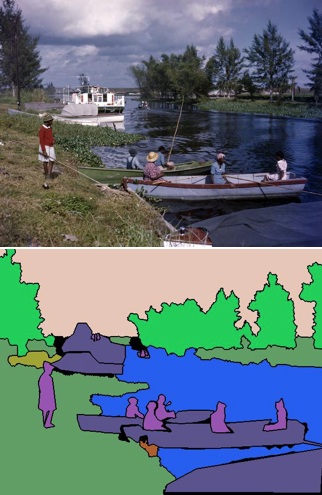At COCO Annotator, we specialize in providing accurate and reliable annotations for COCO Panoptic Segmentation Task, ensuring that our clients’ models achieve the highest level of performance.
About
COCO Panoptic Segmentation Task is a popular computer vision task that integrates both object detection via bounding boxes and semantic segmentation through segmentation masks. This comprehensive approach requires annotating each pixel in an image with semantic label, a category label and an instance ID, indicating which object instance the pixel belongs to.
The task is inherently challenging, demanding high accuracy and consistency in annotations, including the creation of precise bounding boxes and segmentation masks. This level of detail is crucial for various real-world applications such as autonomous vehicles, medical imaging, and robotics.
At COCO Annotator, we specialize in delivering high-quality annotation services tailored to these complex requirements. Leveraging our deep expertise in the COCO Panoptic Segmentation Task, we can generate accurate segmentation masks and identify object instances, ensuring the annotated data meets the highest quality standards for your business needs.

Comparison
Segmentation in computer vision involves dividing a digital image into multiple segments, generally with the goal of simplifying the image into something easier to analyze. Semantic segmentation and instance segmentation are two key methodologies in this area.
While semantic segmentation categorizes each pixel into one of the predefined classes without differentiating object instances, instance segmentation, often simply called “object instance segmentation,” goes a step further to separate different instances of the same class.
Incorporating panoptic segmentation combines the best of both worlds: it classifies each pixel using techniques similar to semantic segmentation while also distinguishing between different object instances in a manner similar to instance segmentation.
Categorizes every pixel into a class (e.g., car, tree, road).
Does not differentiate between multiple instances of the same class (e.g., two different cars are considered as belonging to the ‘car’ class, with no distinction between them).
Also categorizes each pixel into a class.
Separates different instances of the same class (e.g., Car 1, Car 2).
Combines semantic and instance segmentation.
Classifies each pixel and distinguishes between object instances.
Also takes into account “stuff” classes like sky, road, and grass, which do not have individual instances.
Understanding these differences is crucial for selecting the appropriate segmentation feature extraction technique for your specific project needs, whether you’re looking to simply identify objects in a scene or need to differentiate between individual instances different objects.
what we do
To achieve accurate and efficient results in the COCO Panoptic Segmentation task, it requires various key image segmentation techniques, including instance segmentation techniques, to be implemented in the annotation process.

Assigning a label to digital image processing every pixel in an image to identify objects and their boundaries accurately.

Separating individual objects and providing a unique class label for each individual instance used in an image or video is a key feature of instance segmentation.

A deep learning model that combines object detection with instance semantic segmentation and instance name, providing better accuracy and performance.

A network architecture that provides a unified framework for both semantic and instance segmentation tasks.

A model that captures long-range dependencies in an image to improve image segmentation and accuracy.

A technique that learns rich feature representations for each pixel to improve image segmentation technique and quality.
Our Solutions
Panoptic segmentation, as an advanced field in computer vision, offers unparalleled capabilities for object identification and categorization. However, like any technology, it comes with its own set of challenges and limitations. By acknowledging these, we aim to set realistic expectations for our clients and provide targeted solutions to mitigate these issues.
Issue: Panoptic segmentation algorithms often involve complex computations, making them resource-intensive.
Our Solution: We offer optimized algorithms and cloud-based solutions that are designed to run efficiently, reducing the computational load on your local resources.
Issue: Datasets like COCO are often biased towards certain object classes, which can result in models that are less effective at identifying underrepresented categories.
Our Solution: Our data augmentation and re-sampling techniques help to balance the panoptic segmentation datasets, providing a more accurate and holistic model.
Issue: High-quality annotations are crucial for training effective models, but the annotation process can be tedious and error-prone.
Our Solution: We offer state-of-the-art annotation services with a focus on quality and accuracy, including options for manual review and validation by experts in the field.
Issue: Models trained exclusively on panoptic segmentation datasets like COCO may not generalize well to real-world scenarios, which could include different lighting conditions, object orientations, or occlusions.
Our Solution: Our domain adaptation techniques and robust testing processes ensure that the models we deliver perform well under varied real-world conditions.
Issue: As your project grows, you may encounter difficulties in efficiently scaling your object detection tasks.
Our Solution: Our services are designed with scalability in mind, offering easy integration with your existing infrastructure and the ability to handle increased data loads without a significant performance hit.
Issue: The use of panoptic segmentation technology can raise privacy and ethical issues, especially in applications like surveillance.
Our Solution: We provide consultation services to help you navigate the legal landscape, ensuring that your project is compliant with relevant data privacy regulations and ethical guidelines.
Understanding these challenges allows us to offer a more tailored solution to our clients. Our focus is on ensuring that our COCO Image Captioning systems and services meet your needs while addressing these inherent complexities, thereby providing a more robust and reliable system.
industries
Our COCO Stuff Segmentation Task can benefit a wide range of industries that require accurate image annotation for object detection and image segmentation methods. Some of the industries we can assist include retail, healthcare, agriculture, and more.
With COCO panoptic segmentation task, retailers can accurately identify the presence and location of products on shelves. This information can be used to optimize shelf space and inventory management.
COCO panoptic segmentation task can be used to identify and analyze crops, helping farmers to improve crop yield, detect diseases, and optimize irrigation.
COCO panoptic segmentation task can be used in medical imaging to identify and show segmentation masks different tissues and organs. This can help doctors and researchers in disease diagnosis and treatment.
COCO panoptic segmentation task can be used to help self-driving cars detect and classify objects on the road, improving safety and efficiency.
COCO panoptic image segmentation task can be used to identify and track people, vehicles, and objects in video surveillance footage, providing real-time situational awareness for security personnel.
COCO panoptic segmentation task can be used to monitor construction sites and track the progress of projects. This can help construction companies to optimize resource allocation and improve project management.

What You Get
MORE INFO
COCO Panoptic Segmentation is an advanced image annotation technique that combines semantic segmentation (categorizing pixels into object classes) and the instance segmentation techniques (identifying individual object instances) into a unified framework. It provides a comprehensive understanding of both visual representation and the types and identities of objects in an image.
While semantic segmentation classifies each pixel of input image into a specific category (e.g., car, tree, etc.), and instance segmentation identifies individual, separate instances of objects, Panoptic Segmentation effectively does both. It offers a more integrated and holistic understanding of an image scene.
Industries such as healthcare, autonomous vehicles, robotics, agriculture, and smart cities can greatly benefit from the COCO Panoptic Segmentation Task. The method’s comprehensive object understanding is ideal for complex vision tasks, like medical imaging analysis or urban planning.
A high-performance computer with a capable GPU is generally required to process Panoptic Segmentation tasks. Additionally, expertise in machine learning and computer vision is helpful for customization and troubleshooting.
The accuracy of COCO Panoptic Segmentation highly depends on the quality of the algorithms and training data used. With high-quality data and fine-tuned algorithms, it is one of the most accurate panoptic segmentation models and techniques available.
Yes, Panoptic Segmentation can often be integrated with other annotation methods like keypoint annotation or bounding boxes, depending on the specific requirements of your project.
One of the main challenges is computational complexity due to the detailed level of annotation. Moreover, it may require a large volume of annotated training data for accurate performance.
The timeline for a Panoptic Segmentation project can vary based on several factors, such as other datasets such as the complexity of images and the volume of data to be annotated. Contact us for a more tailored estimate.
Costs can vary depending on the project’s complexity, the number of images, and the level of customization required. For a customized quote, please get in touch with us.
You can get started by reaching out to us through our contact form or by giving us a call. Our experts will guide you through the consultation, planning, and implementation stages.
Get In Touch